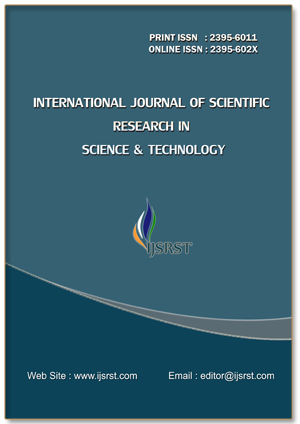Assessment of Physico-Chemical and Biological Factors in Relation to Productivity Potential of A Fresh Water Bodies Of Bhikhanpura, Muzaffarpur (Bihar)
DOI:
https://doi.org/10.32628/IJSRST25121183Keywords:
Water Quality, Bhikhanpura, Productivity, Plankton, Macrohytes, ZooplanktonAbstract
Water quality is a key factor that affects harvest outcome from fresh water body. Irregular or a periodic variations of different water quality variables can influence the growth, survival, and yield of aquatic livestock in the ponds. The basic understanding of the limnology, productive potentials and fish production of water body is essential for the sustainable development at Bhikhanpura in Muzaffarpur. The area of Bhikhanpura is 24-hectare having depths of about 3.5m. An investigation was conducted on the ecology of productivity, plankton, and macrophytes. The transparency value was low during summer and the pH was slightly alkaline. The monthly mean values of dissolved oxygen were somewhat lower in this closed water body. The nitrate values were higher in summer and lower during the monsoon period. Among the plankton, community, phytoplankton formed the main portion of the total plankton. Cyanophycean was the major contributor among the phytoplankton as Chlorophyceae was the second largest group. The monthly mean value of the zooplankton population was 417.20µl-1 in Bhikhanpura. The water body contain a mixed population of macrophytes with the dominance of submerged plants throughout the year. Fish production was recorded at 1158.80 kg/ha/yr. However, the production of carps was much higher than the miscellaneous fishes.
Downloads
References
Abbassi, S.A., D.S. Arya, A.S. Hameed and N. Abbassi: Water quality of a typical: river of Kerala, punnurpuzha. Pollut. Res., 15, 163-166 (1996)
Adesalu, T.A. and D.I. Nwankwo: Effect of water quality indices on phytoplankton of a Sluggish tidal creek in Lagos, Nigeria. Pakistan J. Biol. Sci., 11, 836-844 (2008). DOI: https://doi.org/10.3923/pjbs.2008.836.844
Adoni, A., D.G. Joshi, K. Gosh, S.K. Chourasia, A.K.Vaishya, M. Yadav and H.G. Verma: A workbook on limnology (Pratibha Publisher) Sagar (1985).
Ahmad, M.S. and E.N. Siddiqui: Freshwater diatoms of Darbhanga. J.Fresh. Biol., 7, 41-48(1995).
Ahmad, M.S.: Ecological survey of some algal flora of polluted habitats of Darbhanga., J. Environ. Pollut., 3, 147-151 (1996)
Ahmad, M.S. and R. Krishnamurthy: Preliminary observation of the growth and food of Muriel, Channa marulius block of the river Kali in North India. J. Freshwater Biol., 2, 47-50 (1990)
Alfred, J.R.B., S. Bricice M.L. Issac, R.G. Michael, M. Rajendran, J.P. Royan, V. Sumitra and J. Wycliffe: A guide to the study of freshwater organisms. J. Madras univ. Suppl., 1, 103-151 (1973).
APHA: Standra methods for the examination of water, sewage and industrial wastes. 14th Edn., APHA Inc., New York. P. 1193 (1975)
Arora, J. and N.K. Mehra: Seasonal diversity of planktonic and epiphytic rotifers in the backwaters of the Delhi segment of the Yamuna river, with remarks on new records from India. Zoological Studies, 2, 239-49 (2003).
Banerjee, S.M. 1967. Water quality and soil condition of fish ponds in some states of India about fish production. Indian J. Fish., 14(182):115-144.
Bhattacharya, K.G., N.Kapil, 2010. Impact of urbanization on the quality of water in a natural reservoir: A case study with the deeper lake in Guwahati city, India. Water and Env. J., 24:83-96. DOI: https://doi.org/10.1111/j.1747-6593.2008.00157.x
Bhaumik, U. 2001. Eco- dynamics and fisheries management of some lakes and its impact on the socio-economic status of the operatives in Bihar. Kurukshetra University, Kurukshetra, 308 pp.
Bhowmik, M.L. 1988. Limnology and productivity ofsome lakes and baors of Biharwith reference to recent development. Environ. & Ecol.,6(1): 42-47.
Chakrabarti, P. 1980. Studies on the hydrobiology of some freshwater fisheries. Ph.D. Thesis, Muzaffarpur University, India. 251pp.
Das, P.K.1983. A model for upper tertiary sedimentation of Arunachal Predesh with special reference to Subansiri district. J. Assam Sci. Soc. 25(2): 66-69.
Jayram, K.C.1981. The freshwater fishes of India, Pakistan, Bangladesh, Burma and Srilanka, Hand book of Zoological Survey of India.
Kumar, K. 1985. Hydrobiological investigations of afreshwater lake with special reference to its fish production potentialities. Ph.D. Thesis, Bhafgalpur University, Bihar, India.
McCauley, E. and J. Kalff, 1981. Empericalrelationships between phytoplankton and zooplankton biomass in lakes. Can. J. Fish. Aquat. Sci., 38(4): 458-463. DOI: https://doi.org/10.1139/f81-063
Mukhopadhyay, M.K. 1997. Ecology of the lakes in Bihar. In: Fisheries enhancement of small reservoirs and floodplain lakes in India. Eds. V.V. Sugunan and M. Sinha. CIFRI Bull. 75:187-190.
Nath, D. 1999. Role of biotic factors in the management of fisheries in the open water system, In: Open water fisheries technologies and extension methods, CIFRI Bull. 96: 86-90.
Piper, C.S.1966. Soil and plant analysis. Hans Publishers, Bombay, 368 pp.
Sharma, U.P. 1995. Role of macrophytes in the ecosystems of Karwar Lake wetland (Begusarai).
Freshwater Biol., 7(2): 123-128.
Sinha, M. 1997. Floodplain wetlands, an important inland fishery resource of India. Aquae. Asia, 2(4):8-10.
Sinha, M. 1998. Wetlands and their implications on fisheries. Meenbarta, Dept. of Fisheries, Bihar, p. 11-14.
Sinha, M. 2001. Reservoir and important fishery resources of India and its utilization for increasing fish production in the country. CIFRI Bull., 106: 1-15.
Sivalingam, P., M. Swamy and R.T. Reddy, 2013. Zooplankton diversity concerning the physicochemical parameters of Kaijjarla Lake, Adilabad district, Andra Pradesh. Indian Inst. Res. J. Biol. Sci., 2(1): 24-28.
Sugunan, V.V., G.K. Vinci, B.K. Bhattacharya and A. Hassan, 2000. Ecology and fisheries of lakes in Bihar. CIFRI Bull., 103: 53.
Talwar, P.K. and A.G. Jhingran, 1991. Inland fishes of India and adjacent countries. Oxford and IBH, New Delhi.
Tamuli, P., S.K. Bhagabati, R. Dutta. A.S.N. Zaman, J. Sarma, A. Choudhury, Mudoi, L.P. and D.J. Debnath, 2018. Physico-chemical characteristics of 47 nos. Morakolonglake, Morigaon district, Central Brahmaputra Valley zone, Assam. Int. J. Chemical Stud. 6(5):748-754.
Toner, R.C. 1981. Interrelationships between biological, chemical, and physical variables in mount Hope Bay. Massachusetts, USA. Estuarine Coastal Shalf Sci., 12(6): 701-712. DOI: https://doi.org/10.1016/S0302-3524(81)80066-7
Yadav, Y.S.1987. Studies on the Limnology and productivity of a Ladaura lake in Dhubri district of Assam. Ph.D. Thesis, Guwahati Univ., Assam. Pp 320.
Downloads
Published
Issue
Section
License
Copyright (c) 2025 International Journal of Scientific Research in Science and Technology

This work is licensed under a Creative Commons Attribution 4.0 International License.
https://creativecommons.org/licenses/by/4.0





